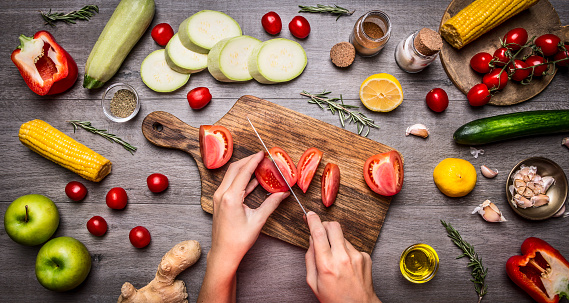
Hygiene measures for preparing food
Know how to handle food in the kitchen to prevent infections
Rinsing fruit under the tap is something that we tend do do automatically before we put it in our mouths. We do it because we think that the water will wash away the remains of bacteria and pesticides on the skin. But, do you know which foods must be cleaned?
Washing certain products is a basic hygiene measure to prevent the risk of intoxication, because bacteria that may cause illnesses may survive and be spread to other foods, and even, through kitchen utensils.
The Spanish Agency of Food Security and Nutrition advises, first of all, watching our personal hygiene to avoid food poisoning. Wash your hands thoroughly before eating, after using the bathroom, after changing nappies, after coughing and blowing your nose, if you have touched an animal, disposed of the rubbish and before and after cooking.
However, cleanliness is not always synonymous with safety. Sometimes, in our enthusiasm to be clean, we make things worse. There are some feeds that we shouldn’t wash. First of all, we need to know how to tell them apart.
How to handle different foods
Fruit and vegetables
– Wash them whole, even if you are going to peel them. This removes bacteria, any soil and pesticides. If you are going to eat them raw, they will not be cooked to remove any pathogens.
– In case of fruits with thick skin, you can use a brush to clean them better. In case of small fruits, like strawberrries and blackberries, they can be soaked for a few minutes and then drained.
– To wash them properly, remove the leaves from the ftuit and vegetable that may be in poor condition, hold them under running water and then dry them with a dry cloth or with kitchen paper.
– If you have touched meat, before you touch the fruit or vegetables, disinfect your hands and all other surfaces (chopping boards, plates, knives…) and utensils that you have touched, with soap and water.
– There’s no need to wash vegetables supplied in bags (ready to eat), because they have already been thoroughly sterilised.
Meat and Poultry
– The UK Food Standards Agency recommends that you do not wash chicken before cooking it, because of the risk of spreading campylobacter bacteria on your hands, kitchen surfaces, cooking appliances and clothes when the water splashes.
– Cook meat through: most bacteria are partly or completely destroyed with proper cooking. Make sure that none of the parts are left raw, particularly the thickest parts.
– Do not wash beef under the tap, either, for the same reasons mentioned above. If you wash it, it will also be much drier when cooked.
– In the case of minced meat, sausages and hamburgers, it is a good idea to cook them, ensuring they reach a temperature of 60ºC, to guarantee that the pathogens disappear.
Eggs
– Do not wash: when an egg is washed there is a danger of cross-contamination (transferring bacteria from one food to another).
– Do not put them in the fridge, because they are exposed to a lot of contaminants when stored here.
– Egg shells are porous and they have a thin layer of natural protection which, if washed, can allow some micro-organisms to penetrate.
These daily habits will enable you to stop bacteria from spreading and infections from developing. Although there is no need to be alarmist, it is a good idea to be careful in the kitchen.
Your health is in your hands.
This post is also available in: Italian
